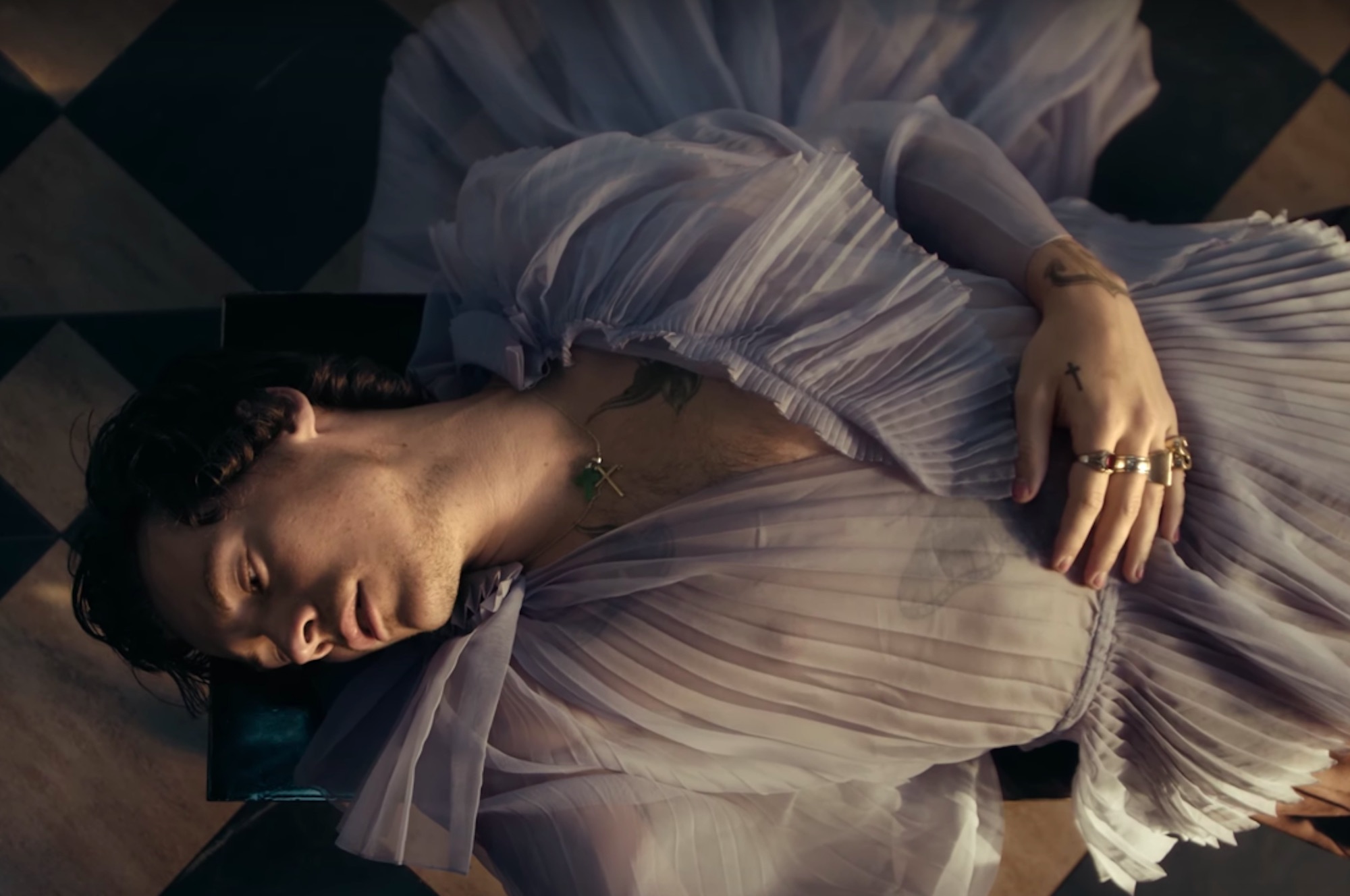
In recent years, Harry Styles has become as well-known for his fashion choices as he is for his music. Since leaving One Direction in 2015, the 26-year-old has experimented more and more with his aesthetic music videos, red carpet appearances and photoshoots, often opting to ditch historically masculine pieces for more traditionally feminine attire, such as tutus, pussy-bow blouses and bright pink suits.
But his most recent photoshoot, for the cover of US Vogue, garnered more attention than ever. Standing in a field in London, Styles wore a floor-length Gucci gown underneath a structured black blazer, becoming not only the first man to front the cover of the publication solo in 127 years, but the first to do so wearing a dress.
Immediately, the singer was praised by thousands of people worldwide for following in the footsteps of great musicians before him, such as David Bowie, Elton John, Freddie Mercury and Prince, in breaking down barriers of toxic masculinity and gender stereotypes. In a viral tweet, one person wrote, ‘My brother just came downstairs wearing a dress and said “If Harry Styles can wear one, then so can I.”’
“One time I saw @Harry_Styles wearing a blazer and a dress. So I bought a blazer and a dress.” pic.twitter.com/r4HrUxt9hT
— Derrick Barry (@DerrickBarry) November 14, 2020
In an accompanying interview for the shoot, Styles addressed his gender-neutral way of approaching fashion, saying, “When you take away ‘There’s clothes for men and there’s clothes for women,’ once you remove any barriers, obviously you open up the arena in which you can play. I’ll go in shops sometimes, and I just find myself looking at the women’s clothes thinking they’re amazing. It’s like anything — anytime you’re putting barriers up in your own life, you’re just limiting yourself.”
But when it’s a white cis man being held up as the face of the gender non-conforming movement, many have questioned whether it’s cause for celebration. “The thing about this Harry Styles debate is black boys dress like that all the time,” Kalen Allen wrote on Twitter. “But when we do it we are seen as emasculating the culture, less than, and feminity is seen as unattractive. That’s not a Harry problem, that’s homophobia and a double-standard problem.”
Let me hear one more thing about Harry Styles wearing a dress without mentioning Young Thug who pioneered the way for this shit pic.twitter.com/MSoBT3WULN
— Pain & Misery In Atlanta
(@BreakTheBlue) November 15, 2020
Others have raised the valid question of whether or not Styles is “queerbaiting”—giving ‘clues’ that he is queer, without ever confirming it. Given that Styles has only ever been romantically associated with traditionally beautiful, straight white women (such as Kendall Jenner, Taylor Swift and Camille Rowe), it raises eyebrows that he also insists on using LGBTQ+ themes, messaging and colourways to build his personal brand. Styles was asked, point-blank, if he was appropriating queer culture to make himself more marketable to the “woke” generation in an interview with The Guardian, in 2019. “Am I sprinkling in nuggets of sexual ambiguity to try and be more interesting? No,” was his response. “I want things to look a certain way. Not because it makes me look gay, or it makes me look straight, or it makes me look bisexual, but because I think it looks cool. And more than that, I dunno, I just think sexuality’s something that’s fun. Honestly? I can’t say I’ve given it any more thought than that.”
Following the release of Styles’ latest magazine cover, gender non-conforming writer and performance artist Alok Vaid-Menon— who receives abuse and threats daily for their choice to wear feminine dresses while also keeping, for example, traditionally masculine body hair—perfectly articulated what many were feeling on Instagram. They were annoyed at the noise surrounding Styles’ latest cover (as if he’s the first and only man to embrace feminity on the public stage!) but not placing blame on the man himself.
“A lot of people have been asking me what I think about it and I’ll say this: I am holding simultaneity and choosing abundance over scarcity. Am I happy to see Harry be celebrated for openly flouting gendered fashion norms? Yes. Do trans femmes of color receive praise for doing the same thing every day? No. Do I think this is a sign of progress of society’s evolution away from binary gender? Yes. Do I think that white men should be upheld as the face of gender neutral fashion? No,” they wrote.

“It’s a curious thing this: holding space for joy, while also insisting on a more expansive form of freedom,” they continued. “We can both acknowledge this unprecedented moment while also remembering that it could only happen because of the resistance of trans femmes of color. We who for decades were imprisoned by cross-dressing legislation. Make no mistake: trans femmes of color started this and continue to face the backlash from it. Our aesthetics make it to the mainstream, but not our bodies. We are still dismissed as “too much” and “too queer” because we aren’t palatable enough to whiteness and heteronormativity. Is that Harry’s fault? No. It’s the fault of systems of transmisogyny and racism.”
So while Styles wearing a dress on the cover of a huge fashion publication, which has historically reinforced gender norms, is definitely a step in the right direction (and yes, he looks incredible while doing it), it pays to note that many—and many of whom are Black, trans or gender-nonconforming—have paved the way before him. Moreover, it’s worth noting that the many others who choose to dress the way Styles did for the cover of Vogue don’t hold the same status, and won’t be treated with 

